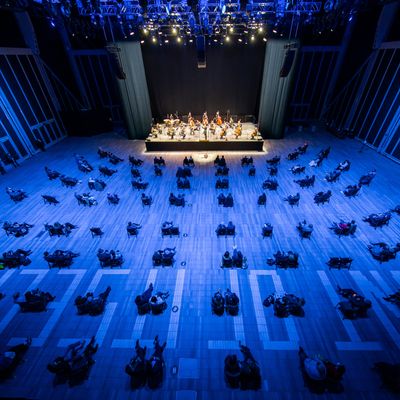
Before the conductor Esa-Pekka Salonen gave the signal for the New York Philharmonic’s first live public sounds in over a year, he told the audience what he had come to understand: that music fully exists only in the comity and rituals of live performance. I agree. During all these silent months, faced with a cornucopia of livestreams and the constant availability of nearly all recordings ever made, I let my musical diet wither to almost nothing. I don’t know why I rejected what was available and pined for what was not, but I did. So when it finally came time to file into a concert hall and sit down before a few dozen tuning musicians, it was like rediscovering a strange, forgotten rite. Then the orchestra plunged into the first tremulous chords of Caroline Shaw’s Entr’acte, and I felt an unfamiliar mixture of panic and solace.
Nothing about the Philharmonic’s — or rather the string section’s — return was normal. The concert took place in the vastness of the Shed’s McCourt Theater in a deserted Hudson Yards, and the sound drifted up into the lighting rig and stayed there. The ventilation hummed so reassuringly that it swallowed high frequencies and muffled pianissimos. Everyone was masked, which for a conductor who has spent decades refining his non-verbal communication, must have felt like having his baton hand tied behind his back. The tiny audience (having shown proof of vaccination or a negative test and having had their temperatures taken) was spread so thin that even enthusiastic applause sounded meager. But when the strings’ rich whiskey tone rolled over the edge of the stage, bobbing on a wave of double bass, then it was clear that — for an hour, at least — everything was going to be all right.
The program was heavy on mournfulness and nostalgia. Shaw’s sensuously sad piece ends with all the instruments but one skittering softly into the upper register and petering out, like a fine drizzle. Only a solitary cello is left, plucking out a cadenza full of stammers and silence. I would have loved a more celebratory evening, to hear the orchestra’s full thunder and blare bang against vibrating walls. But we’re not there yet. The full experience (complete with seatmates coughing and snoring inches away) is still at least six months off, and even then it will take place in a borrowed venue while Geffen Hall is being rebuilt. In the meantime, the Philharmonic left us with an elegy for unimaginable loss: Richard Strauss’s Metamorphosen.
Composed in the final months of World War II, when it seemed that all Europe had collapsed into a pile of ash and exhaustion, the half-hour work is usually seen as an old man’s tragic, tear-streaked memory. All those chords glowing like polished leather, the glacial pace, the muted counterpoint in baritone register, the way the main motive stumbles down a set of stairs — everything suggests a funereal held beneath a lowering sky. This time, though, I heard glimmers of restless energy, perhaps because I sensed the orchestra’s joy at finally doing what it exists to do: play! It now seemed to me that Strauss had surveyed the rubble and gotten to work, fashioning a single, perfect brick for all who might one day need to rebuild. Here, the slow strings murmur: This is how you begin.
